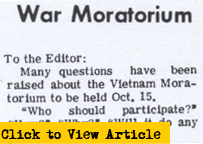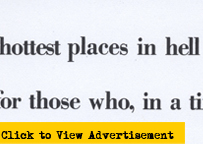
Intermittently throughout the late 1960s, young people enrolled at Wisconsin State University at Oshkosh (WSU-O) joined students at many other colleges and universities throughout the United States in protesting against the war in Vietnam. While controversies surrounding the “Black Thursday” protests waged by African American students in November 1968 overshadowed the issue of the war during the 1968-1969 school year, the ongoing war in Southeast Asia would dominate student activists' attention the next year. With Republican Richard Nixon in the White House and no end to American intervention in Southeast Asia in sight, liberal and left-wing students who returned to the campus in the fall of 1969 were prepared to engage in a new round of protests.
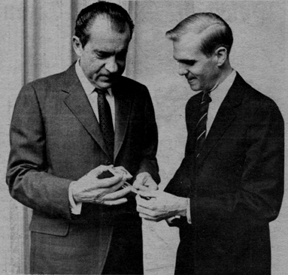
Congressman William Steiger of Oshkosh shares "Great Silent Majority" stickers--originated by WSU-O political science professor Charles Goff--to President Richard Nixon in late 1969, several weeks after Nixon coined the phrase "silent majority" in reference to law-abiding conservatives. Advance-Titan photo, December 18, 1969.
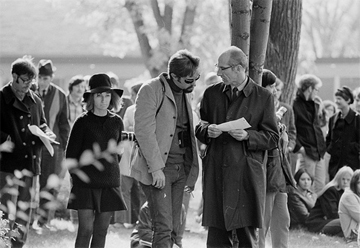
In concert with the nationwide Moratorium to End the War in Vietnam, WSU-O students, faculty, and Oshkosh clergymen jointly staged activities which they hoped would further educate local citizens on the evils of American military action in Southeast Asia. “There are too many people here who can't tell the Cong from the Corps and most have never heard of the Geneva Accords,” the Advance-Titan student newspaper explained of the motivations behind the October 15 Moratorium. "When you run up against the kind of brick wall Mr. Nixon has put up and when you lack the vote, but not the conviction, you use what tools you can."
Although WSU-O president Roger Guiles did not bow to student demands that the university be shut down for a teach-in on October 15, he and his administration announced that they would not stop students from using campus facilities to engage in meetings and forums. While the basement of Fletcher Hall served as the site of a contentious panel, the lawn in front of Dempsey Hall provided the venue for a two-hour assembly criticizing the war. History instructor Stephen Kane was among several people to speak out against the war, but neither he nor any other speaker matched the emotional intensity of a reluctant veteran who related “the horrors of the war in which children under 12 were disemboweled in front of their parents” and now disavowed pride in wearing his military uniform. The October 15 Moratorium Day activities were capped by a 2,000-person candlelight march to the steps of the Winnebago County Courthouse, where a rally featuring a speech by an antiwar veteran kept peaceful protestors' attention well into the evening.
History professor Robert Delk, a member of the Moratorium-organizing committee, discusses details of the unofficial campus teach-in with a newspaper photographer
UWO Archives Photo 69-403.16.
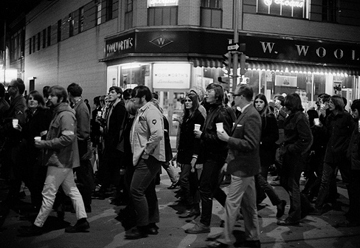
The candlelight march progressed to the courthouse via Main Street in downtown Oshkosh.
UWO Archives
Photo 69-395.17.
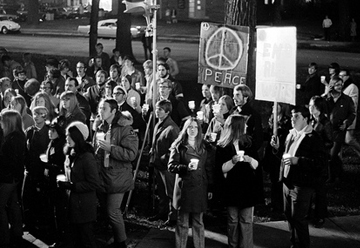
down Main Street in support of the Moratorium on October 15.
UWO Archives Photo 69-395.29

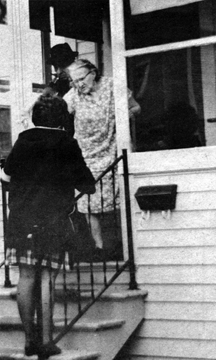
Campus conservatives, together with the many local citizens who found little to criticize in President Nixon's handling of the war, objected strenuously to the disruptions on campus, the presence of antiwar students canvassing in local neighborhoods, and the spectacle of Quakers reading off the names of those killed in the war on the steps of the courthouse. Faculty members who disagreed with the Moratorium refused to reschedule examinations slated for October 15 and secured the backing of the administration to "punish" absent students. In reaction to the groundswell of conservative support President Nixon elicited with his November 6 speech praising law-abiding Americans, political science professor Charles Goff designed and began to peddle a patriotic red-white-and-blue sticker depicting the U.S. shield and bearing the slogan "Great Silent Majority."
Advance-Titan photo, October 16, 1969.
Advance-Titan photo, October 16, 1969.
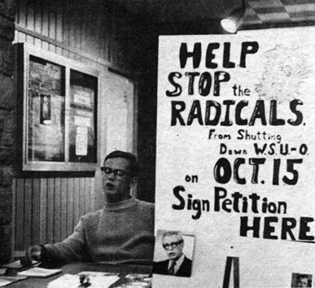
Advance-Titan photo, October 9, 1969.
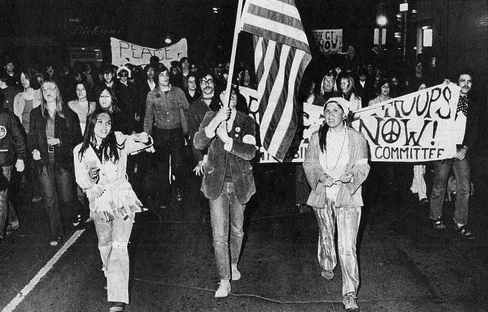
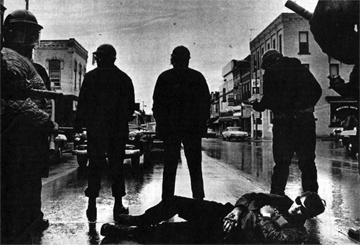
for the October 15 Moratorium in the pages of the campus newspaper.
Advance Titan, October 9, 1969.
The Paper of Central Wisconsin photo, April 16, 1970.
strong throughout October.
Advance Titan ads, October 9, 1969.
The Paper of Central Wisconsin, April 13, 1970.
